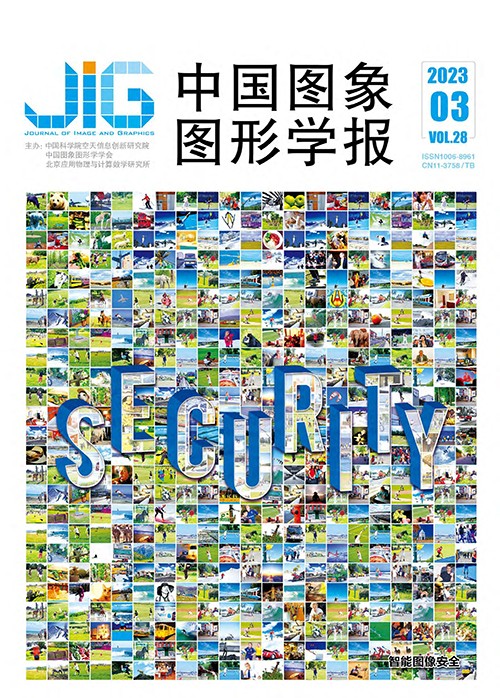
利用功能图形的防伪码图像盲去模糊
摘 要
目的 防伪码是一类经过特殊设计的QR(quick response)码,在防伪和溯源领域有着广泛应用。模糊的防伪码图像不利于解码和真伪鉴别,需要进行去模糊操作。目前主流的盲去模糊算法在用于防伪码图像时,去模糊效果不好且算法消耗时间较长。对此,本文提出一种基于防伪码功能图形的盲去模糊优化算法。方法 首先,定义了防伪码图像的强度先验和梯度先验。强度先验是图像像素的灰度值,而梯度先验是图像像素水平方向和垂直方向的差分。然后,将整幅模糊防伪码图像均分为左上、左下、右上、右下4块,提取左上、左下、右上3个位置的探测图形和右下的校正图形。最后,将强度先验和梯度先验作为约束项,利用正则化方法求出4个分块的清晰图像和模糊核。结果 本文测试了100幅人工添加模糊的防伪码图像和50幅手机实际拍摄的模糊防伪码图像,采用峰值信噪比(peak signal to noise ratio,PSNR)、结构相似度(structural similarity,SSIM)和自然图像质量评价器(natural image quality evaluator,NIQE)作为图像清晰度评价指标。从实验结果来看,相较于对比算法的最优结果,本文算法在手机拍摄的模糊防伪码图像数据集上的平均NIQE降低了3.02,复原时间缩短了22.07 s,且能较好地恢复防伪图案的细节信息。在人为添加模糊的防伪码图像数据集上,本文算法的性能也优于对比算法,且能够处理不同程度的运动模糊和离焦模糊。结论 本文提出的防伪码图像盲去模糊优化算法简单易实现,在保证一定去模糊效果的前提下,算法耗时大幅缩短。
关键词
Functional patterns-relevant blind-deblurring method for anti-counterfeiting code images
Liu Chang, Zheng Hong, Wang Tianyu, Zhou Chengzhuo(School of Electronic Information, Wuhan University, Wuhan 430072, China) Abstract
Objective Anti-counterfeiting code can be as a sort of quick response (QR) code-special design. The functions of anti-counterfeiting and traceability of QR code are involved in beyond encoding and decoding. So, the quality of anti-counterfeiting code images is highly required for that. Actually, the obtained anti-counterfeiting code image is challenged to be blurred due to camera-derived noise, the relative shooting motion between camera and anti-counterfeiting code, and its errors-defocused. Generally, QR codes-relevant slight blur degradation does not have a great impact on the function-decoded of anti-counterfeiting codes in terms of its own error-modified ability, but the function of authenticity identification is still a challenging issue to be resolved via the restoration for blurred anti-counterfeiting code images. Most of current blind deblurring algorithms are aimed at natural images, which do not make full use of the features of anti-counterfeiting code. The restoration result is not effective and time cost is high as well. To resolve this problem, we develop a blind-deblurring method on the basis of anti-counterfeiting code’s functional patterns. Method First, the blurred anti-counterfeiting code image is converted into grayscale and interpolation-bilinear is used to coordinate its size to 512×512 pixels. The intensity and gradient priors of anti-counterfeiting code image are re-identified in terms of its binary features. Intensity-prior means the gray values of clear anti-counterfeiting code image are concentrated between 0 and 255, while anti-counterfeiting code image-blurred are scattered between 0 and 255. Gradient-prior is defined as the difference between adjacent image pixels, which has horizontal and vertical directions. The gradient distribution of clear anti-counterfeiting code image is amongst 0, 255 and -255, whereas gradient values of blurred image are scattered between -255 and 255. Then, the entire blurred anti-counterfeiting code image is divided into four blocks with the same size: 1) upper left, 2) lower left, 3) upper right, and 4) lower right. After that, the three image position detection patterns of upper left, lower left and upper right and the correction pattern of lower right are extracted respectively. There are two potentials of block processing as mentioned below. The first one is beneficial for the deblurring-regularized method, which is scale-related temporal optimization. The other one is focused on comparative analysis for estimating the blur kernel of whole image to make deblurring result better in terms of non-uniform blur-melted block processing. Finally, intensity and gradient-priors cost function is as the constraints, and the deblurring problem is decomposed into two subproblems. The clear images and blur kernels of four blocks are generated based on regularization method and numerical method. Result First, we test 100 artificial blur-relevant anti-counterfeiting code images. The updated blur types consist of motion blur, defocus blur and the two blurs-coordinated. To evaluate the performance of those algorithms to be tested, peak signal to noise ratio (PSNR), structural similarity (SSIM) and the time cost are used as the indicators. The experimental result shows that our algorithm can deal with varied degrees of motion blur and defocus blur. Next, we test 50 blurred anti-counterfeiting code images collected by mobile phones. Natural image quality evaluator (NIQE) is used as the image quality evaluation index. Our average NIQE value is decreased by 3.02 and the time cost is optimized by 22.07 s compared to some popular algorithms, including blind image deblurring using patch wise minimal pixels regularization. Furthermore, the details of anti-counterfeiting pattern can be restored well. Conclusion To guarantee certain deblurring effect and time efficiency, our easy-to-use blind-deblurring optimization of anti-counterfeiting code images is demonstrated.
Keywords
anti-counterfeiting code blind deblurring functional pattern intensity prior and gradient prior regularization image quality evaluation
|



 中国图象图形学报 │ 京ICP备05080539号-4 │ 本系统由
中国图象图形学报 │ 京ICP备05080539号-4 │ 本系统由